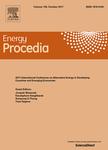版权所有:内蒙古大学图书馆 技术提供:维普资讯• 智图
内蒙古自治区呼和浩特市赛罕区大学西街235号 邮编: 010021

作者机构:Department of Engineering Universidad de Bogotá Jorge Tadeo Lozano Cr. 4 22-61 Bogotá 110311 Colombia Mewbourne College of Earth and Energy The University of Oklahoma 660 Parrington Oval Norman OK 73019 United States Engineering and Industrial Production Program Universitat Politecnica de Valencia Camí de Vera s/n 46022 Valencia Spain
出 版 物:《Energy Procedia》 (能源会议集)
年 卷 期:2019年第157卷
页 面:825-836页
学科分类:08[工学] 0807[工学-动力工程及工程热物理]
主 题:Microgrids renewable energy solar energy wind energy battery storage
摘 要:Energy microgrids have acquired great importance recently thanks to their main characteristics: decentralized generation, use of renewable energy sources in a distributed way, energy storage capacities and the possibility of controlling and managing the use of power flows. This makes the microgrids an excellent option to reduce losses in the transmission and distribution lines and to reduce the use and dependence on fossil fuels worldwide. This article presents a methodology for designing and simulating renewable energy microgrids to operate in countries located near the equator. For this, several mathematical models are proposed for the different components of a microgrid: photovoltaic generator, wind turbine, battery bank and inverter for connection to the electricity grid. Solar and wind resources of five Colombian cities at low latitudes are analyzed: Barranquilla, Santa Marta, Cartagena, Riohacha and Lorica; through NASA’s satellite measurement databases. Through the use of neural networks, microgrids are modeled to meet the monthly energy demand of residential users in the proposed cities. The power curves, energy, performance factor and performance variables of the designed systems are presented and discussed. The results allow to validate the excellent energy option represented by microgrids for low-latitude countries, with good rates of solar radiation and wind speed.